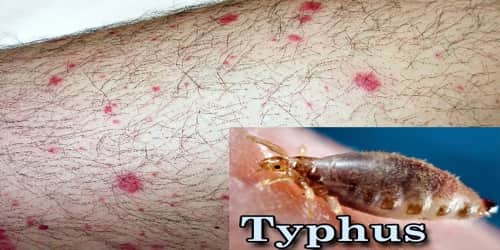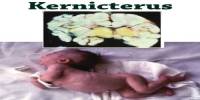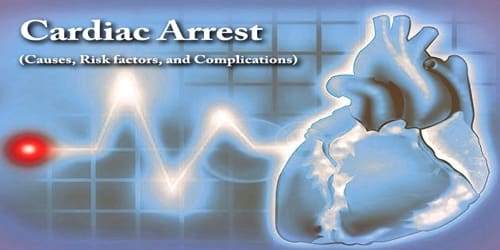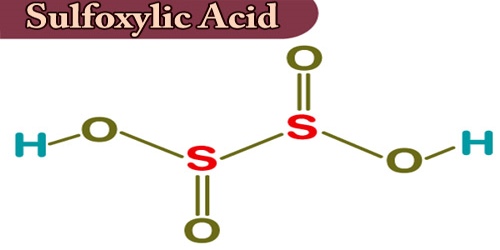About Typhus
Definition: Typhus is a disease caused by infection with one or more rickettsial bacteria. It is also known as typhus fever. Common symptoms include fever, headache, and a rash. Typically these begin one to two weeks after exposure.
Typhus is caused by different species of Rickettsia bacteria that are transmitted to humans by lice, fleas, mites, or ticks. The insects have carried person to person or are brought to people by rodents, cattle, and other animals.
There is currently no commercially available vaccine. Prevention is by reducing exposure to the organisms that spread the disease. Treatment is with the antibiotic doxycycline.
There are three different types of typhus:
- epidemic (louse-borne) typhus
- endemic (murine) typhus
- scrub typhus
The type of typhus people are infected with depends on what bit them. Arthropods are typically carriers of a typhus strain unique to their species.
Typhus has been described since at least 1528 AD. The name comes from the Greek typhus (τύφος) meaning hazy, describing the state of mind of those infected. While “typhoid” means “typhus-like”, typhus and typhoid fever are distinct diseases caused by different types of bacteria.
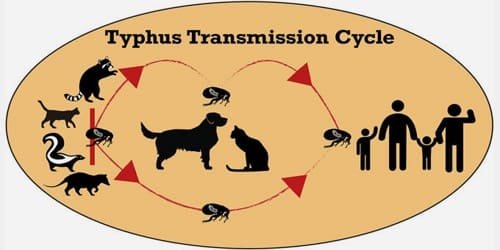
Causes, Sign, and Symptom of Typhus: The causes of typhus are small Gram-negative coccobacilli-shaped bacteria, members of the genus Rickettsia that are intracellular parasites of many animals and utilize the components within the cell to survive and multiply. Typhus is sometimes generally labeled as flea-borne, tick-borne typhus, or louse-borne typhus, depending on the vector that transmits the bacteria. Occasionally, the bacteria may become dormant in infected cells, and years later, again begin to multiply (causing Brill-Zinsser disease).
The two Rickettsia species responsible for the two main types of typhus are Rickettsia prowazekii, the cause of epidemic typhus, and R. typhi, the cause of endemic typhus.
Scrub typhus is usually classed as a separate disease entity. Tick-borne typhus is also classed as a separate disease called spotted fever.
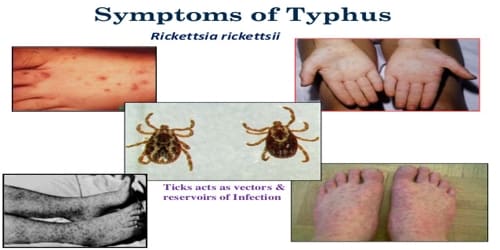
Symptoms vary slightly by the type of typhus, but there are symptoms that are associated with all three types of typhus, such as:
- headache
- fever
- chills
- rash
Symptoms of epidemic typhus usually appear suddenly and include:
- severe headache
- high fever (above 102.2°F)
- rash that begins on the back or chest and spreads
- confusion
- stupor and seeming out of touch with reality
- low blood pressure (hypotension)
- eye sensitivity to bright lights
- severe muscle pain
The symptoms of endemic typhus last for 10 to 12 days and are very similar to the symptoms of epidemic typhus but are usually less severe. They include:
- dry cough
- nausea and vomiting
- diarrhea
Symptoms seen in people with scrub typhus include:
- swollen lymph nodes
- tiredness
- red lesion or sore on the skin at the site of the bite
- cough
- rash
Patients may develop additional symptoms of bleeding into the skin (petechiae), delirium, stupor, hypotension, and shock, which can be life-threatening.
Diagnosis and Treatment of Typhus: Medical professionals base their diagnosis on the patient’s clinical history, physical exam, and tests based on an identification of the bacterial genus and species by PCR testing of a skin biopsy from skin rash or lesions, or blood samples. Typhus can also be diagnosed, usually late or after the disease has been treated with antibiotics when significant titers of anti-rickettsial antibodies are detected by immunological techniques.

Antibiotics are used to treat the infection. People are usually started before they get their test result, as this can take up to a week.
Antibiotics most commonly used to treat typhus include:
- doxycycline (Doryx, Vibramycin): the preferred treatment
- chloramphenicol: an option for those not pregnant or breastfeeding
- ciprofloxacin (Cipro): used for adults who are unable to take doxycycline
Most people start to feel better within 48 hours of starting treatment. It’s important to keep taking their antibiotics until they’re finished, even if they feel better. People with severe typhus may need to be treated in hospital.
Information Source:
